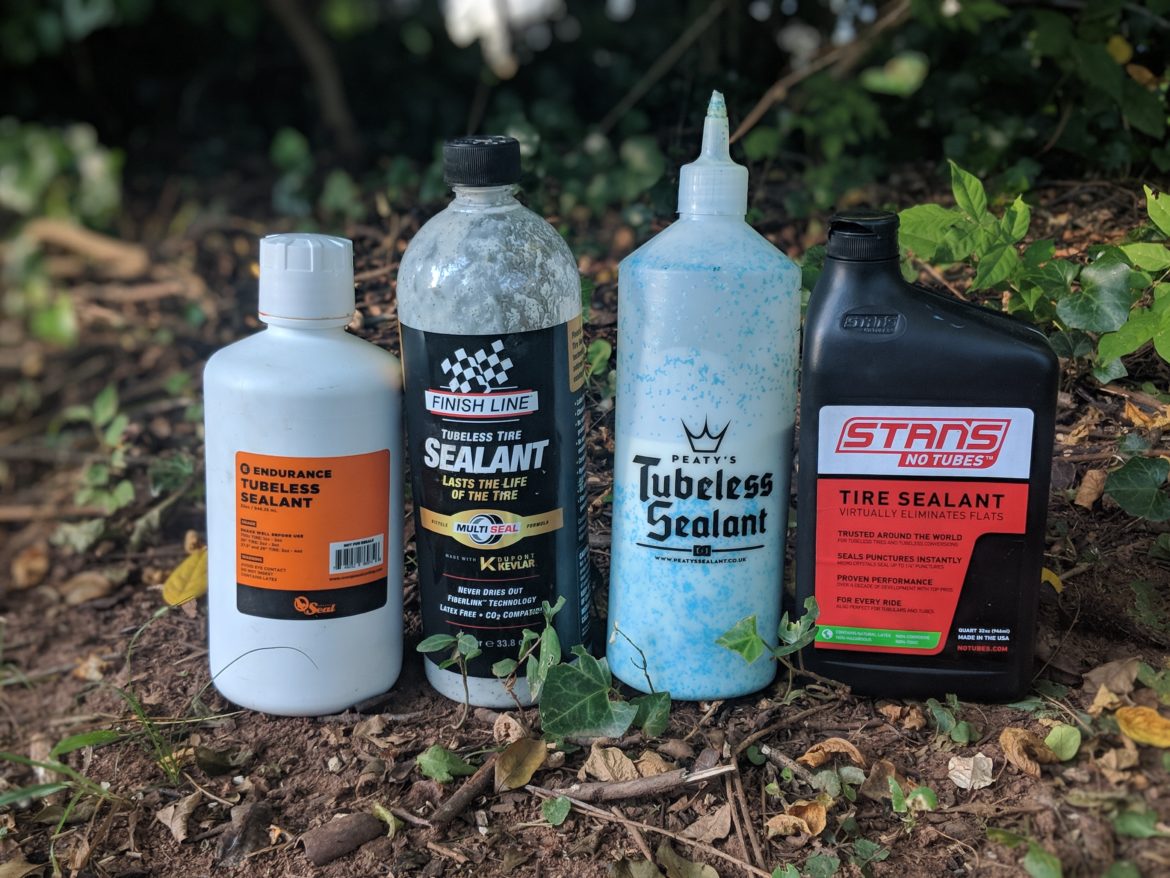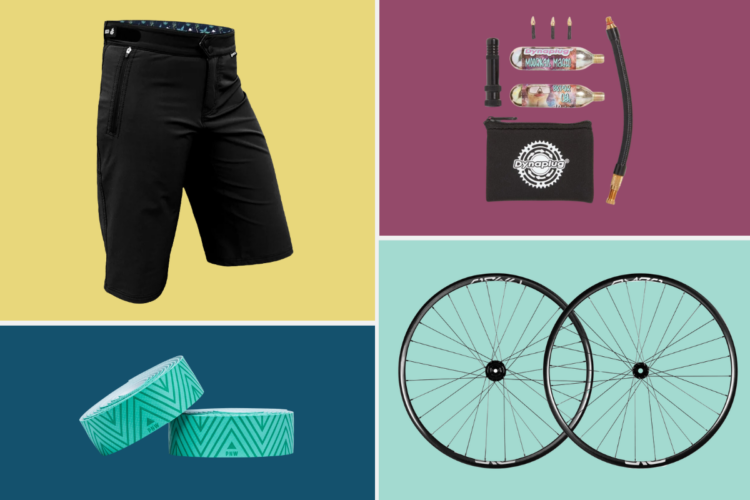
Since the advent of tubeless tire technology, latex based sealants have been the most common option. While tubeless tire sealants are great at sealing punctures, they tend to dry up over time which requires periodic cleaning and re-filling. Recently, there have been several new options popping up making claims that their tire sealant will never dry. The current liquid, latex-based standards are fantastic, but if the new tire sealants require less maintenance, it could be a game changer. I decided that I wanted to test out some of the new competition against the trusty standards to see how they hold up over time.
The Tubeless Tire Sealant Test
In this tubeless tire sealant test, we were sent shop size samples from four different tire sealant companies. I used a different sealant in four different tires, each ridden between 50 to 100 miles per week. The test was done over a period of four months to see how well each sealed punctures, but also to see how they hold up to their marketing claims. I set up each tire using the instructions provided by the manufacturer. I also unseated each tire once a month to check sealant levels. In the end, I never faced any massive punctures or cuts, but each tire did see many small punctures during the test.
Stan’s No Tubes Tire Sealant

Stan’s No Tubes has been the longtime standard for tubeless sealants. Back in 2001, Stan’s brought tubeless technology to the cycling market for the first time. Using a liquid, latex-based formula, Stan’s tubeless sealant does a tremendous job of sealing punctures quickly. The only downside is that over time it dries up, which requires cleaning and re-filling. Most mountain bikers overlook this minor chore because of how dependable Stan’s is.
I used Stan’s sealant in a 29 x 2.2 Maxxis Ikon tire. To keep the test as accurate as possible, I installed the recommended 3 oz, rather than just eyeballing it. Once the tire was seated, I heard air escaping from a few spots in the sidewall. I spun the wheel a few times to allow the sealant to coat the whole tire, and the sound stopped.
After my first month of riding, Stan’s tire sealant held up exactly as it always has. I had a few small punctures that had been filled, and the tire was reliably holding air day in and day out. When I popped the bead, I measured 2.2 ounces of liquid still in the tire. The rest of the sealant had thoroughly coated the inside of the tire, and there were no signs of “Stanimals” yet. I actually found the exact same results when I popped the bead after two months as well.
The biggest surprise I ran into was after 3 months. When I popped the bead, I noticed that there was only about one ounce of liquid remaining and the inside of the tire had become even more coated than before. The tire was still holding air with no problem, and I hadn’t had any issues with punctures, even when riding sketchy urban trails riddled with broken glass.

Once I hit the four month mark, I was very eager to see what was left inside the tire. After removing the tire completely, I found that there was still about one ounce of liquid sealant in the tire. In the four months of regular riding, there had been a few small punctures, but never any large gashes or cuts for the sealant to deal with. That being said, I have used Stan’s for years, and have seen it close up many impressive cuts. The tubeless tire sealant did its job, and was reliable for the whole test.
- Price: $34 (32 oz)
- Find Stan’s No Tubes Sealant at Amazon or compare prices.
Peaty’s Tubeless Tire Sealant

Peaty’s Tubeless Sealant is a new product from pro downhiller Steve Peat. This non-toxic, biodegradable sealant is non-latex based, and claims to never dry out or ball up. The sealant has blue “nano-platelets” that are designed to coagulate and fill punctures. With a downhill pedigree, Peaty’s is designed to hold up to the toughest punctures.
I installed this sealant in a 29 x 2.2 Maxxis Ikon as well. Peaty’s recommends about 3.5 oz for a 29er. The first thing I noticed when installing the sealant was the viscosity. It looks and feels a lot like Elmer’s glue. Once I got the tire seated I noticed that some of the “nano-platelets” had gotten on the rim, and combined with the sealant were fairly difficult to clean off. There were a few hissing spots in the sidewall, but they quickly sealed up upon spinning the wheel.

After less than a week of riding, I noticed the tire had lost a significant amount of air. I attached my gauge and it read 8 PSI. I had never experienced a tubeless tire lose that much pressure in only a few days. I checked the tape and valve and everything looked ok. I re-inflated the tire to 30 PSI to see if the added pressure would help keep everything sealed. The next morning the tire was back down below 10 PSI. I also noticed significant “weeping”of sealant on the sidewalls.

For the remainder of the test, I constantly had to reinflate the tire to keep it at pressure. When I popped the bead after the first month, I noticed that there was no liquid sealant at all. It wasn’t dried up in the same way that latex-based sealants do, It covered the inside of the tire evenly, but was dry and plastic feeling.
After my experience with the sealant, I suspect that it might just be Elmer’s glue with blue glitter added. I never had a chance to get any punctures because after using the recommended amount, it was entirely dry after one month. It was no longer holding air long enough for me to trust it out on the trail.
- Price: $45 (1L/34 oz)
- Find Peaty’s Tubeless Tire Sealant at Amazon or compare prices
Orange Seal Endurance Tubeless Tire Sealant

Orange Seal is another latex-based tubeless tire sealant that many people swear by. With a claimed life of 60-120 days, the new Endurance tire sealant is designed to hold up longer than the original. The Endurance tire sealant sacrifices some of the sealing power of original Orange Seal, in exchange for longer times between refilling. Orange Seal requires the same maintenance as Stan’s, but is also known for having the same reliability.
I used Orange Seal Endurance tubeless tire sealant in a Maxxis Rekon 27.5×2.8″ tire. Being a plus tire, I had to use a bit more sealant than usual. Per their suggestion, I installed 4 ounces of tire sealant and setup was a breeze. I had no hissing from the sidewalls, and the tire held air without any spinning. Orange Seal claims that their endurance tire sealant will last more than twice as long as their regular sealant, but will not seal punctures quite as well.
After one month of riding I measured 3 ounces of sealant in the tire. The inside of the tire had been coated in sealant, and was holding air extremely well. There were several times where I would go for more than a week before pumping the tire at all. When inspecting the tire, I noticed several punctures that had been sealed, that I hadn’t even noticed while riding.
After two months of regular riding, I popped the bead and found about 2 ounces of tire sealant inside. I also noticed that compared to the other sealants, I had barely been losing any air each week. I was fairly lucky, and didn’t have any serious punctures during the first few months of testing. At this point, Orange Seal seemed to be an even match for Stan’s when it comes to reliability. Even after three months, I measured 2 ounces of Orange Seal sealant in the tire.

At the four month mark, I unseated the tire and found about half an ounce of tire sealant remaining. In my test I had no issues with Orange Seal tubeless tire sealant whatsoever. It had successfully sealed many small punctures, and had kept the tires at pressure without issue.
- Price: $40.83 (32 oz)
- Find Orange Seal Endurance Tubeless Tire Sealant at Amazon or compare prices.
Finish Line Tubeless Tire Sealant

Longtime chain lube brand Finish Line recently announced their ambitious new sealant. Finish Line claims that their sealant will never dry and lasts the life of the tire. In partnership with Dupont, they developed FiberLink™, a kevlar-based fiber designed to fill the most stubborn of punctures. The sealant is non-toxic, hypoallergenic, and cleans up easily with water.
I used a Maxxis Ikon 27.5×2.8 for the Finish Line tubeless tire sealant. I installed the recommended 4 ounces, and seated the bead. The first thing I noticed when working with this sealant was how watery it felt. The consistency makes it very easy to install through a valve. I didn’t notice any hissing coming from the tire, but I did experience a condensation-like effect on the sidewalls.
The day after setting up my tire using the Finish Line tire sealant, it had lost nearly all pressure. I went through the usual troubleshooting steps, and found no issues with my setup. I re-inflated the tire, and left it alone for a few hours. Upon returning, it had lost most of its pressure again. I thought that riding it would allow the sealant to get more evenly distributed. After riding for an hour, I had to inflate my tire again. I popped the bead when I got home and noticed that the sealant had not coated the tire at all. It was still liquid, but unless I had a tire that was not porous at all, it would continue to leak air.

After one month, I gave up on the Finish Line tire sealant. Not only was my tire going flat overnight, but once I popped the bead I noticed that it didn’t coat the tire at all. It had become a strange blue oily film on the inside of my tire. Even though there was plenty of sealant in my tire, it still would not hold air for longer than 24 hours.
- Price: $39.99 (1L/33.8 oz)
- Find Finish Line Tubeless Tire Sealant at Amazon or compare prices
Conclusion
After my four-month test, my results were pretty close to what I expected. Stan’s and Orange Seal tire sealants won out by a massive margin. They are the classics, because they work consistently. The liquid latex sealants do a great job of sealing punctures, but also handling porosity in different tires.
The new school of tubeless tire sealants that “never dry” lack the ability to seal small imperfections in the tire, and thus never quite get the job done. Both Finish Line and Peaty’s sealants came onto the market with very strong claims of being far superior to the current standard, and both failed to stand up to the basic task of even holding air.
After the four months were up; I pulled all of my tires, cleaned them, and refilled them. I put Stan’s tire sealant in one set of tires, and Orange Seal in the other. Both are still the gold standard, and I will gladly use them each on any bike I ride.
















